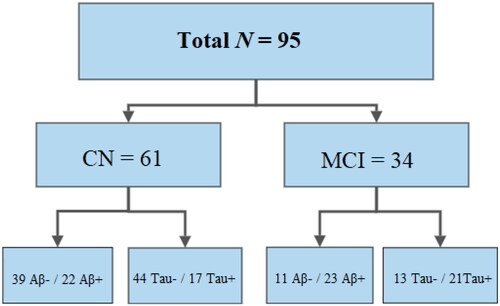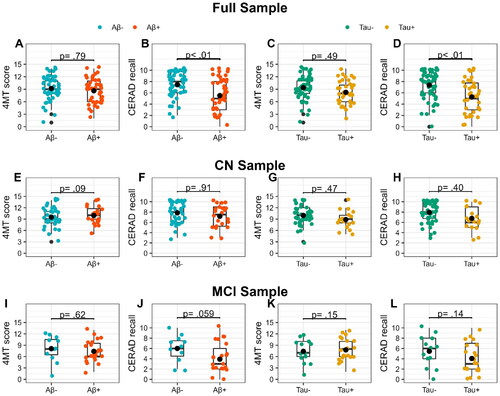Figures & data
Table 1. Descriptive Statistics for Aβ-/+ and Tau-/+ participants in CN and MCI samples.
Figure 1. Flowchart of participants grouped by cognitive status and Aβ and Tau status.
The flowchart illustrates how many Aβ-/ Aβ+ and Tau-/Tau + participants were included in the CN and MCI sub-samples. N = sample size; CN = cognitively normal; MCI = mild cognitive impairment; Aβ-/+ = CSF Aβ42/40 ratio above/below cutoff; Tau-/+ = CSF p-tau concentration below/above cutoff.

Figure 2. 4MT and CERAD recall scores in Aβ-/Aβ+ and Tau- /Tau + participants across All samples. The box plots show differences in 4MT and CERAD recall scores between Aβ- (blue) and Aβ+ (red), and between Tau- (green) and Tau+ (yellow) participants in the full sample (A, B, C, D), the CN sample (E, F, G, H), and the MCI sample (I, J, K, L). All analyses are adjusted for differences in age, years of education, and sex. Black dots indicate the adjusted mean for each group. The only significant difference was found in the full sample (B and D), where Aβ+ and Tau + participants performed worse on the CERAD recall compared to Aβ- and Tau- participants. p = p-value; Aβ-/+ = CSF Aβ42/40 ratio above/below cutoff; Tau-/+ = CSF p-tau concentration below/above cutoff; 4MT score = 4 Mountain Test total score; CERAD recall = CERAD word list memory test recall score.

Table 2. Regression models for 4MT and CERAD recall across samples.
Figure 3. Plots of correlations between 4MT scores and cognitive screening tests in the full sample. The plots show correlations between 4MT performance and the VOSP silhouettes test (a), Trail Making Test-A (B), Trail Making Test-B (C), FAS verbal fluency test (D) and CERAD recall scores. Only correlations in plots A, B and C were significant. r = Pearson correlation coefficient; p = p-value.

Supplementary Materials
Download MS Word (17.3 KB)Data availability statement
The data used in this study is not openly available due to patient confidentiality. The data supporting these findings may be made available upon reasonable request from the corresponding author, pending ethical approval by the regional ethical committee (Helse Sør-Øst). The data is stored at a secure server (Tjenester for sensitive data, TSD) at the University of Oslo in compliance with the General Data Protection Regulation (GDPR).
